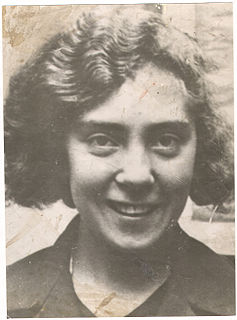 W
WTosia Altman was a courier and smuggler for Hashomer Hatzair and the Jewish Combat Organization (ŻOB) during the German occupation of Poland and the Warsaw Ghetto Uprising.
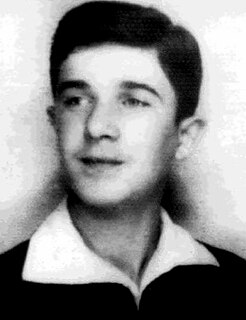 W
WMordechai Anielewicz was the leader of the Jewish Fighting Organization, which led the Warsaw Ghetto Uprising; the largest Jewish insurrection during the Second World War, which inspired further rebellions in both ghettos and extermination camps. His character was engraved as a symbol of courage and sacrifice, and to this day his image represents Jewish resistance during the Holocaust.
 W
WDawid Moryc Apfelbaum, nom de guerre "Kowal" ("Blacksmith") (?-4/28/1943) was allegedly an officer in the Polish Army and a commander of the Jewish Military Union, during the Warsaw Ghetto Uprising. His very existence have been questioned by some historians, who argue that there is no credible evidence to suggest that there was a person by that name involved in the ŻZW in any capacity.
 W
WFranciszka Arnsztajnowa was a Polish poet, playwright, and translator of Jewish descent. Much of her creative oeuvre falls within the Young Poland period, stylistically encompassing the twilight of neo-romanticism. She is called "the legend of Lublin".
 W
WMeir Balaban or Majer Samuel Bałaban was one of the most outstanding historians of Polish and Galician Jews, and the founder of Polish Jewish historiography.
 W
WZygmunt Białostocki was a Polish Jewish musician and composer. He composed many popular Polish pre-war songs, and worked as conductor and a première pianist in Warsaw between the World Wars.
 W
WAbraham Blum was Polish-Jewish socialist activist, one of the leaders of the Bund in the Warsaw Ghetto and a participant in the Warsaw Ghetto Uprising.
 W
WA well-known Holocaust photograph depicts three Jewish women who fought in the Warsaw Ghetto Uprising, took shelter in a bunker with a weapons cache, and were forced out by SS soldiers. One of the women, Bluma Wyszogrodzka (center), was shot. The other two, Małka Zdrojewicz (right) and Rachela Wyszogrodzka (left) were marched to the Umschlagplatz and deported to Majdanek concentration camp, where Wyszogrodzka was murdered. Jürgen Stroop, the SS officer who commanded the suppression of the uprising, admired the bravery of female combatants and included the photograph in one of the copies of his official report. The photograph has become symbolic of Jewish resistance to the Holocaust.
 W
WDovid Bornsztain, also spelled Borenstein, Bornstein and Bernstein, known as the Chasdei Dovid, was the third Rebbe of the Sochatchov Hasidic dynasty. He succeeded his father, Rabbi Shmuel Bornsztain, as Rebbe upon the latter's death in 1926.
 W
WAdam Czerniaków was a Polish engineer and senator who was head of the Warsaw Ghetto Jewish Council (Judenrat) during World War II. He committed suicide on 23 July 1942 by swallowing a cyanide pill, a day after the commencement of mass extermination of Jews known as the Grossaktion Warsaw.
 W
WPaweł Finder was a Polish Communist leader and First Secretary of the Polish Workers' Party (PPR) from 1943 to 1944.
 W
WMałgorzata Fornalska was a Polish communist activist and anti-Nazi resistance fighter.
 W
WPaweł Frenkiel was a Polish Army officer and a Jewish youth leader in Warsaw and one of the senior commanders of the Jewish Military Union, or the ŻZW. Although one of the most important leaders of the Warsaw Ghetto Uprising and the Jewish resistance in the months preceding April 1943, Frenkiel is also one of the least well known to historians, and both his earlier life and his ultimate fate are a subject of some controversy.
 W
WStefan Fryc was a Polish footballer who played as a defender. He competed in the men's tournament at the 1924 Summer Olympics. He was murdered by the SS during World War II in a mass execution held in the Warsaw Ghetto.
 W
WMira Fuchrer was a Polish Jewish activist of the Jewish resistance movement in the Warsaw Ghetto during the occupation of Poland in World War II; member of the Jewish Combat Organization (ŻOB), and fighter in Warsaw Ghetto Uprising of 1943. Surrounded by the Germans and their auxiliaries, she refused to surrender. It is believed that Mira committed suicide in the ghetto bunker with a group of her co-conspirators.
 W
WJakub Kagan was a popular Polish-Jewish composer, pianist, jazz musician and arranger. In the early 1920s, he formed the Kagan's Jazz Band in Warsaw, performing in operettas, cabarets, and hotels. Since 1922 Kagan was a feature artist at the Kabaret Mirage and at the Teatr Nowości. In 1926 he signed a contract with the luxury Hotel Bristol in Warsaw. His band performed world-renowned standards as well as his own compositions widely popular across the country. He died in Warsaw during the Holocaust in occupied Poland.
 W
WSzymon Kataszek (1898–1943), was a Polish-Jewish composer, bandleader, pianist, a pioneer of Polish jazz. Born in Warsaw 1898; studied piano at the Warsaw Music Institute and Rome's St. Cecilia Academy. He returned to Poland and first worked as an organist in St. Trinity Church, while also playing piano in nightclubs.
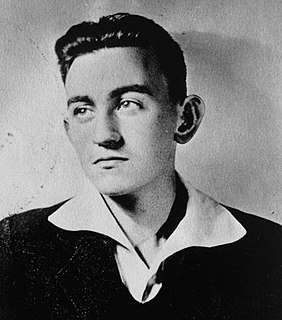 W
WMichał Klepfisz was a chemical engineer, activist for the Bund, and member of the Jewish Morgenstern sports organization. During World War II he belonged to the Jewish Combat Organization, fighting the Nazi German forces in Poland. He was killed in the Warsaw Ghetto Uprising and was posthumously decorated by the Polish government in exile with a Silver Cross of the Virtuti Militari.
 W
WAntoni Kocjan was a renowned Polish glider constructor and a contributor to the intelligence services of the Polish Home Army during World War II.
 W
WRoman Kramsztyk was a Polish realist painter of Jewish descent in the interwar period. He was shot dead in the Warsaw Ghetto in 1942. His work was also part of the painting event in the art competition at the 1928 Summer Olympics.
 W
WJakub Lejkin was a Polish lawyer, deputy commander subordinate to the Germans at the Warsaw Ghetto. He was the administrator from May to July 1942. Lejkin played a leading role in the deportation of local Jews to extermination camps. The Germans nicknamed him “little Napoleon” and adored his brutality.
 W
WJózef Lewartowski was a Polish communist politician of Jewish origin, revolutionary, member of the KPP and PPR one of the first organizers of the Jewish resistance in Nazi occupied Poland, co-founder of the Anti-Fascist Bloc.
 W
WAlfred Nossig was a Polish sculptor, musician, writer, and public activist. During World War II he was imprisoned in the Warsaw Ghetto where he became a member of the Judenrat. He was accused of collaboration and executed by a resistance organization.
 W
WMaurycy Orzech was a Polish-Jewish economist, journalist, politician and a leader of the Jewish Bund in interwar Poland. He was one of the commanders of the Bund during the Warsaw Ghetto Uprising.
 W
WCalel (Calek) Perechodnik was a diarist who joined the Jewish Ghetto Police in the Otwock Ghetto during the Nazi German occupation of Poland. His wartime diaries were published posthumously as Am I a Murderer? in 1995 by the Karta Centre of Warsaw.
 W
WRabbi David Moshe Rabinowicz (1906-1942) was the Rosh Yeshiva of Kibbutz Govoha and the entire Keser Torah network. The network had 36 schools, throughout Poland, with an enrollment exceeding 4,000 students.
 W
WShlomo Chanoch Hakohen Rabinowicz was the fourth and last Rebbe of the Radomsk Hasidic dynasty. He was the eldest son of the third Radomsker Rebbe, Rabbi Yechezkel Hakohen Rabinowicz and great-grandson of the founder of the dynasty, Rabbi Shlomo Hakohen Rabinowicz, the Tiferes Shlomo. Under his leadership, Radomsk grew to be the third largest Hasidut in Poland, after Ger and Alexander. Rabinowicz built a network of 36 yeshivas across Poland and Galicia that enrolled over 4,000 students by 1939. He was murdered in the Warsaw Ghetto together with his entire family.
 W
WLejb (Lutek) Rotblat was an activist of the Jewish resistance movement in the Warsaw Ghetto, a member of Jewish Combat Organisation (ŻOB), and a participant in the Warsaw Ghetto Uprising.
 W
WGershon-Yitskhok Leibovich Sirota was one of the leading cantors of Europe during the "Golden Age of Hazzanut", sometimes referred to as the "Jewish Caruso".
 W
Wƒ
 W
WJózef Andrzej Szeryński was a police-colonel in interwar Poland, inspector for the Lublin district and later – in German-occupied Poland during the Second World War – the commander of the Jewish Ghetto Police in the Warsaw Ghetto. Szeryński was viewed as a collaborator and traitor by the Jewish underground in the Warsaw Ghetto. The Chairman of the Warsaw Ghetto's Jewish Council Adam Czerniaków selected Szeryński to create the Jewish Ghetto Police in 1940. Szeryński was arrested by the German Gestapo on May 1, 1942, for smuggling furs out of the Warsaw Ghetto for personal gain. He was released on the condition of leading the deportation action to Treblinka extermination camp in July 1942. The very next month Jewish underground attempted to assassinate him, unsuccessfully. He remained at the helm of the Ghetto Police until the end of the Grossaktion Warsaw which claimed the lives of over 254,000 Ghetto inmates, men, women and children. He committed suicide right after the next wave of deportations in January 1943.
 W
WWładysław Szlengel was a Jewish-Polish poet, lyricist, journalist, and stage actor.
 W
WIzaak Towbin was a Polish chess master and organizer.
 W
WIzrael Chaim Wilner, nom de guerre "Arie" and "Jurek" was a Jewish resistance fighter during World War II, member of the Jewish Fighting Organization's (ŻOB) leadership, a liaison between ŻOB and the Polish Home Army, a poet, and a participant in the Warsaw Ghetto Uprising.
 W
WAndrzej Włast was a Polish Jewish songwriter. He wrote the lyrics for the 1929 hit song "Tango Milonga" / "Oh, Donna Clara". He died in the Warsaw Ghetto during World War II.
 W
WNathalie Zylberlast-Zand was a Polish Jewish neurologist who died in a Nazi prison during World War II. She published research under several names including Nathalie Zylberlast-Zandowa.
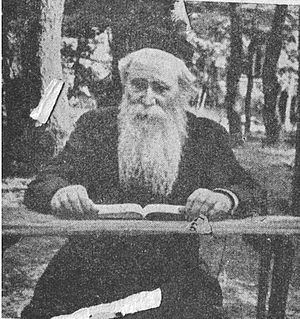 W
WHillel Zeitlin (1871–1942) was a Yiddish and Hebrew writer and poet. A leading pre-Holocaust Jewish journalist, he was a regular contributor to the Yiddish newspaper Moment, among other literary activities. He was the leading thinker in the movement of pre-World War II "philosophical Neo-Hasidism".
 W
WRabbi Menachem Ziemba (1883–1943) was a distinguished pre-World War II Rabbi, known as a Talmudic genius and prodigy. He is known to be fluent in all of Talmud as well as many of the works of the later Rabbis such as Rabbi Joseph Rosen and Rabbi Meir Simcha of Dvinsk. He was gunned down by the Germans in the Warsaw Ghetto.
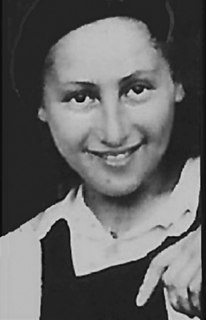 W
WRachel (Sarenka) Zylberberg was an underground activist and participant in the Warsaw Ghetto Uprising. She held a key role in rousing the rebellion. Zylberberg was a member of Hashomer Hatzair, the Zionist-socialist youth movement. After the German invasion of Poland at the onset of World War II, she left the capital for Wilno in northeastern part of prewar Poland, then returned to Warsaw together with Chajka (Chaikeh) Grossman and was actively involved in the Jewish resistance.